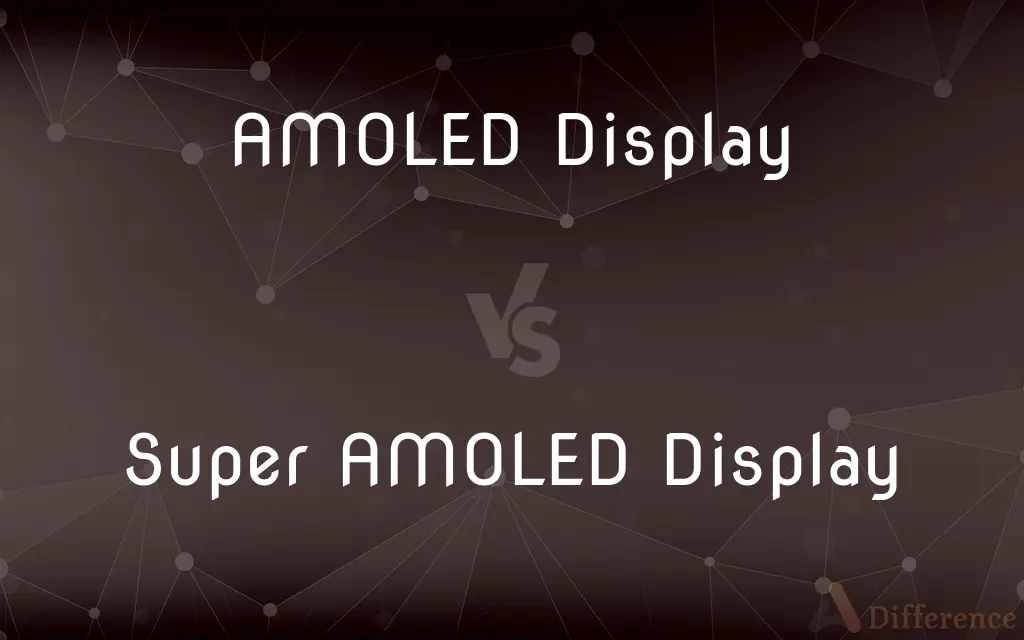AMOLED Display vs. Super AMOLED Display — What's the Difference?
By Tayyaba Rehman — Published on January 28, 2024
AMOLED displays offer vibrant colors and deep blacks using organic LEDs, while Super AMOLED displays integrate touch sensors, offering enhanced brightness and less reflection.

Difference Between AMOLED Display and Super AMOLED Display
Table of Contents
ADVERTISEMENT
Key Differences
An AMOLED (Active Matrix Organic Light Emitting Diode) display is known for its sharp, vibrant colors and deep blacks, as each pixel emits its own light. Super AMOLED displays, an advanced version, further enhance these qualities with integrated touch sensors, resulting in a thinner and more responsive screen.
In terms of energy efficiency, AMOLED displays are more efficient than traditional LCD screens but can still be improved. Super AMOLED displays take this a step further by being even more power-efficient, thanks to their ability to control light emission more effectively.
Visibility in sunlight is a challenge for AMOLED displays due to screen glare. Super AMOLED displays address this issue with better outdoor visibility, offering higher brightness levels and reduced screen reflectance.
The thickness of the screen is another point of distinction. AMOLED displays, while thinner than LCDs, consist of separate layers for display and touch response. Super AMOLED displays merge these layers, resulting in an even slimmer profile and reducing the gap between the user's touch and the display.
In color presentation, both AMOLED and Super AMOLED displays excel, but Super AMOLED provides more vividness and color accuracy, along with improved viewing angles, making the display more visually appealing from different perspectives.
ADVERTISEMENT
Comparison Chart
Integration of Technology
Separate layers for display and touch
Integrated touch sensors in display layer
Energy Efficiency
More efficient than LCDs
Even more power-efficient
Outdoor Visibility
Good, with some screen glare
Better with higher brightness and less reflection
Thickness of Display
Thinner than LCDs
Even slimmer, with integrated layers
Color Accuracy
High with deep blacks
Higher vividness and improved viewing angles
Compare with Definitions
AMOLED Display
A display technology using organic compounds for light emission.
The AMOLED display on my phone provides a stunning visual experience.
Super AMOLED Display
An advanced AMOLED display with integrated touch functionality.
The Super AMOLED display’s responsiveness is unmatched.
AMOLED Display
Known for deep blacks and power efficiency.
I love how the AMOLED display saves battery life on my device.
Super AMOLED Display
Known for its power efficiency and vivid color representation.
The Super AMOLED display makes colors pop, while saving battery.
AMOLED Display
A screen technology that offers vibrant color reproduction.
Photos look incredibly vivid on the AMOLED display.
Super AMOLED Display
Offers a slimmer profile due to the integrated touch layer.
The slimness of the Super AMOLED display makes my phone sleeker.
AMOLED Display
A display that operates without a backlight.
The AMOLED display's ability to turn off pixels individually enhances its contrast.
Super AMOLED Display
Provides wider viewing angles and better color accuracy.
Watching movies is a pleasure on the Super AMOLED display due to its wide viewing angles.
AMOLED Display
Offers improved response times compared to traditional LCDs.
The fast response time of the AMOLED display is perfect for gaming.
Super AMOLED Display
Features enhanced brightness and reduced glare.
Reading on my Super AMOLED display is comfortable even in bright sunlight.
Common Curiosities
Can AMOLED displays show true black?
Yes, as each pixel emits its own light, true black is achieved by turning off pixels.
Do Super AMOLED displays perform better in sunlight?
Yes, they offer higher brightness and less reflection, making them better in sunlight.
What sets AMOLED displays apart from traditional displays?
AMOLED displays offer superior color contrast and energy efficiency by using organic LEDs.
Is the color accuracy better in Super AMOLED displays?
Yes, they generally offer better color accuracy and vividness compared to regular AMOLEDs.
Are AMOLED displays good for the eyes?
They can be, due to their high contrast and adjustable brightness, but screen time should always be moderated.
How is a Super AMOLED display different from a regular AMOLED?
Super AMOLED integrates the touch layer with the display for a thinner, more responsive screen.
How does the thickness of AMOLED compare to Super AMOLED?
Super AMOLED displays are thinner due to the integration of the touch sensor within the display layer.
Are AMOLED displays better for battery life?
Yes, they tend to be more power-efficient than traditional LCDs.
Do AMOLED displays suffer from burn-in?
Yes, AMOLED displays can suffer from burn-in over time, although technology improvements are reducing this risk.
Are Super AMOLED displays more durable?
The integration of the touch layer makes them slightly more durable but not significantly so.
What type of devices commonly use Super AMOLED displays?
High-end smartphones and tablets often feature Super AMOLED displays.
Can AMOLED displays be used for TVs?
Yes, though they are more common in smaller devices like smartphones.
Do Super AMOLED displays use more power than AMOLEDs?
No, Super AMOLEDs are typically more power-efficient due to their integrated design.
Are Super AMOLED displays expensive?
They tend to be more expensive than regular AMOLED and LCD displays, reflecting their advanced technology.
Is the touch responsiveness better in Super AMOLED displays?
Yes, the integrated touch layer generally makes Super AMOLED displays more responsive to touch.
Share Your Discovery

Previous Comparison
Screen Protector vs. Tempered Glass
Next Comparison
Rump Roast vs. Chuck RoastAuthor Spotlight
Written by
Tayyaba RehmanTayyaba Rehman is a distinguished writer, currently serving as a primary contributor to askdifference.com. As a researcher in semantics and etymology, Tayyaba's passion for the complexity of languages and their distinctions has found a perfect home on the platform. Tayyaba delves into the intricacies of language, distinguishing between commonly confused words and phrases, thereby providing clarity for readers worldwide.













































